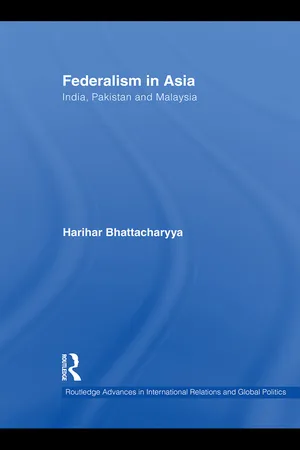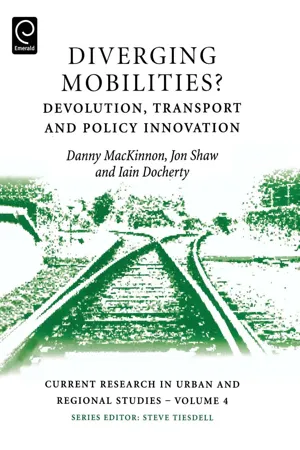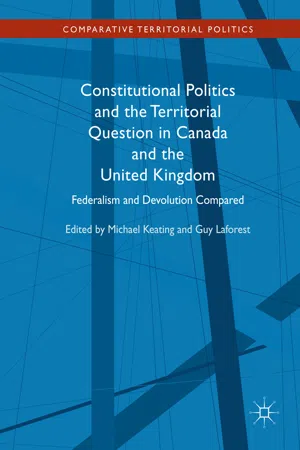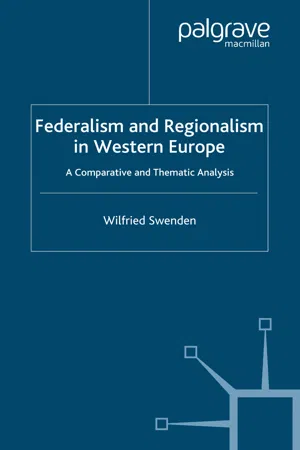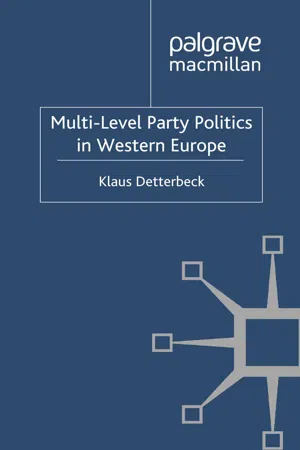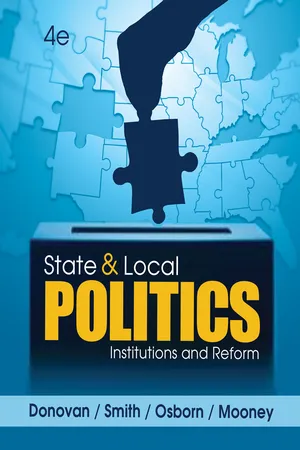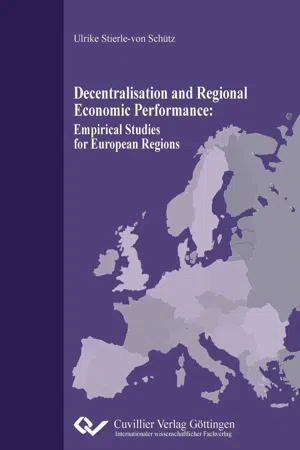Politics & International Relations
Devolution vs Federalism
Devolution and federalism are both systems of decentralizing power from a central government to regional or local authorities. In devolution, power is transferred from a central government to subnational entities, while in federalism, power is divided between a central government and regional governments with each having their own spheres of authority. Devolution often allows for more flexibility and adaptation to local needs, while federalism emphasizes the autonomy of regional governments.
Written by Perlego with AI-assistance
Related key terms
1 of 5
7 Key excerpts on "Devolution vs Federalism"
- eBook - ePub
- Harihar Bhattacharyya(Author)
- 2010(Publication Date)
- Routledge(Publisher)
1 The concept of federalism and its relevanceIntroduction
Federalism appears to be the political principle of the current era, a time that is marked simultaneously by globalization and localization, ‘diminished state sovereignty’, the urge to live with differences, and decentralization. This principle seems to inform many institutional arrangements that the states nowadays are adopting for accommodating various ethno-regional differences and identities both within their ‘boundaries’ and outside of them in transnational modes. The deep-seated Anglo-French preoccupation with the unitary nation-state and the idea of its sovereignty, and the resultant suspicion of federalism and decentralization are passé (John Pinder 2007:1). Pinder has convincingly argued how the British and the French since the twentieth century have slowly worked towards the institutions and processes that have prepared a basis for considering federal arrangements as desirable for the sake of unity and cohesion in the same countries (Pinder 2007:1–3). The rise of the European Union as a viable political association is a case in point (Pinder 2007:3).This post-Cold War globalizing era, in other words, has, as it were, turned increasingly federal. A kind of federal revolution has been sweeping the world over the past few decades. From one estimate, some 40 per cent (about two billion) people globally live under some kind of federation (numbering 24). The post-Soviet renaissance in federalism may not be as surprising, since the Soviet model of the so-called ‘socialist’ federations in the former USSR and Eastern Europe was emptied of the real content of federalism, being highly centralist and undemocratic, and mostly rhetorical: lacking in any real motive for powersharing and hence real autonomy. The Soviet model ultimately failed to offer any durable space for accommodation of ethno-national diversity. The nineteenth century, as Walter Bagehot said (Hobsbawm 1990). was an era of nationbuilding when nations were born by nation-uniting, i.e. disparate elements were united for building national unity in a manner which came to be eulogized the world over as ‘unity-in-diversity’. Federations, or quasi-federations, wherever so adopted, provided one very important mode of nation-building by nation-uniting. The rebirth of many (post-Soviet) nations by splitting from the former Soviet Union, and the fragmentation of Yugoslavia and Czechoslovakia, apparently legitimized a negative principle of nationhood, and were a pointer to the grotesque failure of socialist federations. But the failure of the so-called ‘socialist’ federations did not signify the failure of federalism as such, but the particular design adopted in a fundamentally different, and somewhat inhospitable, political environment. Marxism’s unease with the issues of federalism, identity and difference is well-known (Bhattacharyya 2001a: 41–61). Paradoxical though it may seem, the ‘socialist’ failure in federalism and the resultant state crisis has offered a lesson or two for the rest of the world for rethinking the modes of accommodation of ethno-national identities for state unity. - eBook - PDF
Diverging Mobilities
Devolution, Transport and Policy Innovation
- Danny MacKinnon, Jon Shaw, Iain Docherty, Danny MacKinnon, Jon Shaw, Iain Docherty, Steven Tiesdell(Authors)
- 2008(Publication Date)
- Elsevier Science Ltd(Publisher)
These three sets of conceptual ideas provide the theoretical bases from which the analysis contained in subsequent chapters proceeds, reflecting the notion that devolution is a process not an event. Devolution is inherently about power; its location (territorially or otherwise), deployment and diverse forms of expression. The evolving nature of power relations within the UK state led to devolution becoming adopted by two of the three UK-wide parties in the 1990s, leading to its rapid enactment when Labour gained a landslide victory in the 1997 general election. Adopting Jessop’s terminology, the process of devolution can be seen as a state project around which disparate interests and institutions were united as part of a broader agenda of Devolution, State Restructuring and Regional Government 21 modernisation and renewal. As a process of regional ‘filling in’, linked to the ‘hollowing out’ of the national state, devolution builds on a pre-existing institutional landscape by altering its configuration and establishing new territorial loci of accountability and representation in the form of the new devolved assemblies. This is important since, as we explain in the next chapter, the administration of Scottish, Welsh and Northern Irish affairs was already devolved in an ad hoc fashion and the process of devolution in 1999 has served to align electoral accountability with this pre-existing administrative function ( Mitchell, 2003 ). This pre-existing template interacted with the urgent practicalities of electoral politics to dictate the structure of devolved powers, highlighting some important continuities between administrative and legislative forms of devolution that are overlooked in much of the recent literature ( Mitchell, 2005 ). - eBook - ePub
Constitutional Politics and the Territorial Question in Canada and the United Kingdom
Federalism and Devolution Compared
- Michael Keating, Guy Laforest, Michael Keating, Guy Laforest(Authors)
- 2017(Publication Date)
- Palgrave Macmillan(Publisher)
In the case of the Aboriginal people, they claim their own rights of self-government. In both cases, the question put was whether or not to accept the proposition (independence in Scotland and ‘sovereignty’ in Quebec, when opinion polls showed strong support for an intermediate position. The advantage of the Scottish option, of an agreed question, is that attention during the campaign was focused on the merits of the issue, rather than the meaning of the question; but this did not stop arguments about the full implications of the two options (Keating and McEwen 2017). Centrifugal and Centripetal Forces Federal and devolved systems are rarely in a stable equilibrium but are caught between centrifugal and centripetal forces. Economic change and shifts in economic dynamism can change the balance of forces among parts of the state and between the levels. In some phases, the federal level has a surplus of revenues and can transfer to the federated units, with a consequent enhancement of its power; at other times, the units are better off. Changing patterns of welfare provision and spending can lead to more centralization or decentralization. Political identities are not fixed but can fluctuate and change over time, with the balance between state and sub-state allegiances shifting. States and sub-state nations are the site of competing nation-building and state-building projects, as we have seen in the cases of Quebec and Scotland, with varying fortunes. Federalism and devolution also have their own institutional dynamics. When territories are endowed with their own self-governing institutions, these may have an interest in their own expansion, demanding ever more powers. Political movements in other territories may demand equivalent status, leading to a decentralist dynamic. Federal governments may respond by spreading devolution across the territory in an order to secure symmetry in what the Spanish call café para todos (coffee all round) - eBook - PDF
Federalism and Regionalism in Western Europe
A Comparative and Thematic Analysis
- W. Swenden(Author)
- 2006(Publication Date)
- Palgrave Macmillan(Publisher)
1 Comparative Federalism and Regionalism in Western Europe: a Conceptual Overview 6 1. Federalism and federation A comparative study on federalism and regionalism in Western Europe cannot bypass the thorny issue of defining both terms. I shall take it as the starting point of my analysis. As is the case for many general political con- cepts such as democracy, globalization, or legitimacy, scholars have attrib- uted different meanings to federalism and regionalism. In this chapter, I do not seek to impose my own definition, but shall look for a common denom- inator derived from a set of several authoritative definitions. Subsequently I will seek to apply them in a consistent way throughout this book so that readers have no doubt as to what is meant whenever ‘federal’ or ‘regional- ized’ are used as adjectives. I shall also clarify in what sense federalism and federation are different from ‘multilevel governance’, and how federal (as an adjective) is used differently here from its use by an influential group of (political) economists in their comparative studies of fiscal federalism. Federalism, unlike federation, is in the first place an ideological or norma- tive concept. It reflects a way of living which combines a degree of ‘self’ and ‘shared’ rule (Elazar 1987: 5). Defined in such broad terms, many attributes of political life, even daily life, can be considered as federal (King 1982: 20). Political systems in which citizens share in the governance of a common system, but retain a certain degree of autonomy within any type of subsystem are federal. Federalism reflects ‘unity in diversity’ and as such it has been used as a desirable principle of governance for many political systems, including the EU (Burgess 2000). Defined accordingly, federalism is a very broad concept with a strong normative connotation but also with a very limited analytical value. It is dif- ficult to conceive of any contemporary democracy which does not engrain some sort of federalism. - eBook - PDF
- K. Detterbeck(Author)
- 2012(Publication Date)
- Palgrave Macmillan(Publisher)
2 Federalism, Democracy and Political Parties 2.1 Federalism as political idea and political structure Multi-level governance has become a trendy catchword in the social sciences. It signals the assumed transformation from hierarchical gov- ernment by state institutions to a more flexible system of coordina- tion and bargaining among interconnected state and non-state actors at supranational, state and substate levels. However, its focal point, ‘the dispersion of authoritative decision-making across multiple ter- ritorial levels’ (Hooghe and Marks 2001, xi), is a rather old phe- nomenon in confederal arrangements. Federalism is thus a perfect starting point to sharpen our conceptual lenses with respect to the role parties play in democratic multi-level settings. As mentioned in Chapter 1, the debate on parties in federal settings has rarely been at the centre of academic discourses. However, we will see that there have been quite some interesting debates which can guide our analytical thinking. As a political idea, federalism is a normative concept in which the constituent units cooperate at a central level in the pursuit of com- mon objectives while preserving their spheres of autonomous regulation (King 1982). In aspiring towards ‘unity in diversity’, federalism has been advocated as a desirable form of organizing human communities. In this broad sense, the federal idea as a ‘combination of self-rule and shared rule’ (Elazar 1987, 5) can give rise to a variety of political as well as social arrangements. The European federal tradition has stressed the organic character of compound polities and the importance of collective group identities. By contrast, the American federal tradition has emphasized the checks and balances on political power (Burgess and Gagnon 1993; Burgess 2006). 14 K. Detterbeck, Multi-Level Party Politics in Western Europe © Klaus Detterbeck 2012 - No longer available |Learn more
State and Local Politics
Institutions and Reform
- Todd Donovan, Daniel Smith, Tracy Osborn, Christopher Mooney(Authors)
- 2020(Publication Date)
- Cengage Learning EMEA(Publisher)
Due to electronic rights, some third party content may be suppressed from the eBook and/or eChapter(s). Editorial review has deemed that any suppressed content does not materially affect the overall learning experience. Cengage Learning reserves the right to remove additional content at any time if subsequent rights restrictions require it. Federalism: State and Local Politics within a Federal System 43 policy responsiveness is enhanced when politi-cal authority is dispersed among subnational units. Finally, subnational units are able to provide and manage governmental services more efficiently than if they were carried out by the central government. Of course, the decentralization of political power can lead to asymmetrical, or uneven, rela-tions among the states. In the United States, not all states have the same degree of power within the federalist system. Although all states are afforded the same protection and authority under the U.S. Constitution, some states have more clout within the federation because of the relative size of their economies and populations, differences in their socioeconomic and demographic makeup, and dis-parities in their social and cultural environments. These variations have led to differential power rela-tions among the states, as well as between each state and the federal government. 9 Why Federalism? America’s Founding One of the most fundamental struggles in Ameri-can political history has been the turf battle for political power waged between the states and the national (or, as mentioned, federal) government. The cyclical ebb and flow of this tension between the national and state governments has been con-tinuous for over two centuries and is rooted in the founding of the country. - eBook - PDF
Decentralisation and Regional Economic Performance
Empirical Studies for European Regions
- (Author)
- 2013(Publication Date)
- Cuvillier Verlag(Publisher)
These organisations may take other forms than an official governmental governance body as e.g. an elected regional parliament. The government may delegate authority e.g. by creating public enterprises, housing or transportation authorities, special service districts, regional development corporations, or special project implementation units, etc. While these organisations have some discretion in administration and implementation of functions, the policy framework has been established and remains at the national level. Devolution is the transfer of complete authority in terms of decision-making, finance and management of functions to independent units of subnational governments with own corporate status. These local governments are geographically bounded by clear and legally recognized borders. The inhabitants of these regions elect their own representatives, such as mayors and councils, who are responsible for raising the region’s revenue, for making investment and other expenditure decisions, and for providing local public services within the region’s borders. 9 Even privatisation or contracting out of government functions to the private or non-profit sector could be considered as a form of fiscal decentralisation (Stegarescu, 2006). 10 See e.g. Rondinelli (1999); Stegarescu (2006); Crucq and Hemminga (2007), and the continuing Decentralisation Project of the World Bank. Dieses Werk ist copyrightgeschützt und darf in keiner Form vervielfältigt werden noch an Dritte weitergegeben werden. Es g ilt nur für den persönlichen Gebrauch. 9 10 The concept of decentralisation Only the last form can be considered as complete decentralisation, since exclusively in a devolved system the local authority enjoys complete autonomy.
Index pages curate the most relevant extracts from our library of academic textbooks. They’ve been created using an in-house natural language model (NLM), each adding context and meaning to key research topics.
